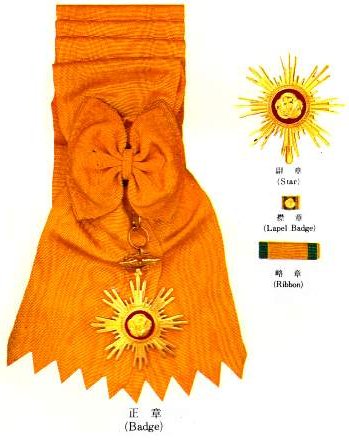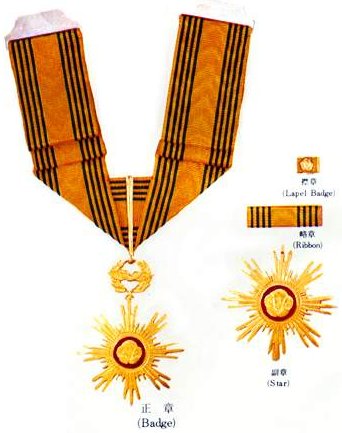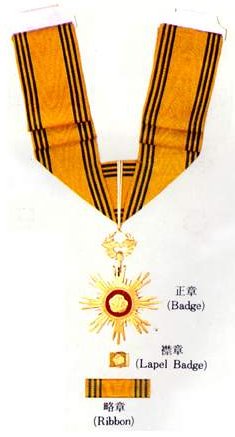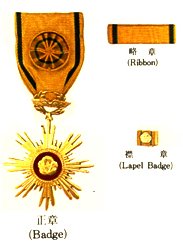The (Original) Order of Civil Merit 국민훈장 (國民勳章)
The Order of Civil Merit is the primary award for Korean Civilians for “Outstanding meritorious services in the areas of politics, economy, society, education, art, or science in the interest of improving citizens’ welfare and promoting national development”.
Tracing the history of the Order Of Civil Merit can be frustrating.
Historically, the Order of the White Star 소성훈장 (素星勳章) is the original Order of Civil Merit. Both the 1958 and the 1964 Korean government publications specifically call this Order, in English, the Order of Civil Merit. However, when the Order was renamed in 1967, it became the Order of Service Merit. To confuse the matter even further, the earlier 1964 Korean publication lists an Order of Service Merit, which in 1967 became the Order of National Security Merit. Later Korean publications list the Order of the White Star as the Order of Service Merit. I am listing it here because, at the time it was issued, it was considered the Order of Civil Merit.
1952 SERIES
The Order of the White Star was promulgated, in four classes, on Dec. 22, 1951 and was put into effect on Jan. 15, 1952 under Presidential Decree #586. The Order of the White Star was awarded to government employees who distinguish themselves with outstanding meritorious services in the performance of their duties. Military personnel and civilian employees of military organizations were excluded.
The Civil Service Law was enacted in August 1949 and has been amended many times since. According to the 1963 legislation of the Civil Service Law, the award criteria for the Order of the White Star, are regulated by the following:
- Blue Stripes or Yellow Stripe’s medal for the rank of 1st Class government employee,
- Yellow Stripes or Red Stripes medal for the rank of 2nd Class government employees,
- Red Stripes or Green Stripes medal for the rank of 3rd Class government employees, and,
- Green Stripes or Bluish Green Stripes medal for government employees, at or below the rank of 4th Class.
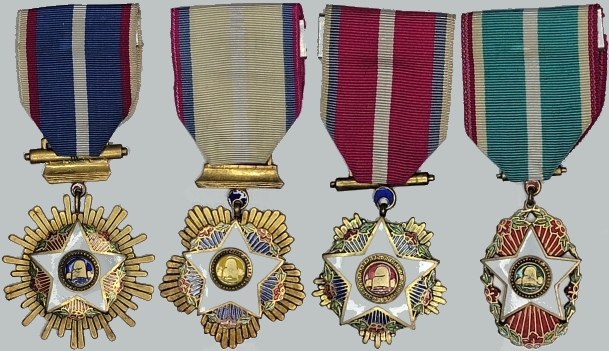
The star and its color express a double meaning. White Star in Korean can be pronounced as “So Sung”. The word “SO” is also the name of a great statesman, Eul Pah So 을파소 (乙巴素), of the Koguryo Dynasty, who was particularly noted in Korean history for his patriotism, righteousness, and dedication to the state. “SUNG” or more properly “Sungho” 星湖 is the literary name of Yi Ik 李瀷 (1681-1763), a famous Sirhak scholar of the Yi Dynasty. He advocated a National Identity derived from historical awareness. Together, the Star and its color symbolize the honesty of government officials. Other symbols are found on these medals. The cap in the center of the star, the chain band around the cap and the small ring, which binds the ribbon to the cap, represent the formal dress of civil officials during the Yi Dynasty (1392-1910). The Mugunghwa and its leaves symbolize national prosperity; the sun’s rays, the enhancement of national prestige; the books and/or scroll on the suspension between the badge and the ribbon, the knowledge and wisdom expected of government officials. The symbolism extends to the ribbons:
- Blue Stripes 청조 (靑條章). The blue color of the ribbon symbolizes high principles and constancy. The pendant has a 48 mm diameter. The 46 × 36 mm ribbon is yellow 황색 (2 mm), red 홍색 (3 mm), blue 청색 (11 mm), white 백색 (4 mm), blue 청색 (11 mm), red 홍색 (3 mm), and yellow 황색 (2 mm). The 36 × 11 mm ribbon bar has the same colors and width dimensions as the ribbon.
- Yellow Stripes 황조 (黃條章). The yellow color of the ribbon indicates national solidarity. The pendant has a 40 mm diameter. The 46 × 36 mm ribbon is Red 홍색 (2 mm), blue 청색 (3 mm), yellow 황색 (11 mm), white 백색 (4 mm), yellow 황색 (11 mm), blue 청색 (3 mm), and red 홍색 (2 mm). The 36 × 11 mm ribbon bar has the same colors and width dimensions as the ribbon.
- Red Stripes 홍조 (紅條章). The red color of the ribbon symbolizes loyalty. The pendant has a 38 mm diameter. The 46 × 36 mm ribbon is yellow 황색 (2 mm), blue 청색 (3 mm), red 홍색 (11 mm), white 백색 (4 mm), red 홍색 (11 mm), blue 청색 (3 mm), and yellow 황색 (2 mm). The 36 × 11 mm ribbon bar has the same colors and width dimensions as the ribbon.
- Green Stripes 록조장 or 녹조장 (綠條章). The green color of the ribbon symbolizes creativity. The pendant is 38 × 20 mm diameter (not including the suspension). The 46 × 36 mm ribbon is red 홍색 (2 mm), yellow 황색 (3 mm), green 녹색 (11 mm), white 백색 (4 mm), green 녹색 (11 mm), yellow 황색 (3 mm), and red 홍색 (2 mm). The 36 × 11 mm ribbon bar has the same colors and width dimensions as the ribbon. The reverse should have the inscription 록조 소성훈장.
1959 SERIES
The Order of the White Star was amended under Decorations Law #1476 on Apr. 10, 1959. The pendants, ribbons, and ribbon bars are identical to the earlier 1952 series. The only noticeable difference is the addition of a lapel pin.
- Blue Stripes 청조 (靑條章). The 18 × 5.5 mm lapel pin is yellow 황색 (1 mm), red 홍색 (1.5 mm), blue 청색 (5.5 mm), white 백색 (2 mm), blue 청색 (5.5 mm), red 홍색 (1.5 mm), and yellow 황색 (1 mm).
- Yellow Stripes 황조 (黃條章). The 18 × 5.5 mm lapel pin is yellow is Red 홍색 (1 mm), blue 청색 (1.5 mm), yellow 황색 (5.5 mm), white 백색 (2 mm), yellow 황색 (5.5 mm), blue 청색 (1.5 mm), and red 홍색 (1 mm).
- Red Stripes 홍조 (紅條章). The 18 × 5.5 mm lapel pin is yellow 황색 (1 mm), blue 청색 (1.5 mm), red 홍색 (5.5 mm), white 백색 (4 mm), red 홍색 (5.5 mm), blue 청색 (1.5 mm), and yellow 황색 (1 mm).
- Green Stripes 록조장 or 녹조장 (綠條章). The 18 × 5.5 mm lapel pin is red 홍색 (1 mm), yellow 황색 (1.5 mm), green 녹색 (5.5 mm), white 백색 (4 mm), green 녹색 (5.5 mm), yellow 황색 (1.5 mm), and red 홍색 (1 mm).
1963 SERIES
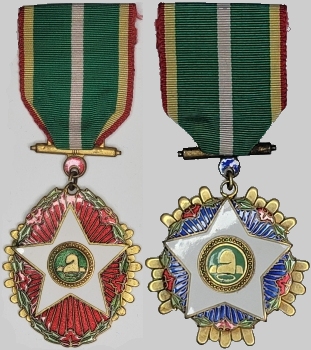
Green Stripes (L.) and Blue-Green Stripes (R.)
The Order of the White Star was modified on Dec. 14th, 1963 under Decorations Law #1519, but its enforcement did not occur until March 1, 1964. A 5th Class was established named Blue-Green Stripes medal 옥조장 (玉條章) There were also considerable changes made to the various classes. The Order now has a sash and breast star for the 1st class, and a cravat, and breast star for the 2nd class. The 3rd class remained with a breast ribbon. Interestingly enough, the legislation does not show a lapel pin. The ribbon bars, their colors, and widths, for the first 4 classes are identical to the earlier series.
- Blue Stripes 청조 The pendant has a 58 mm diameter. The 1,900 × 85 mm sash is yellow 황색 (2.5 mm), red 홍색 (4 mm), blue 청색 (12.5 mm), white 백색 (9 mm), blue 청색 (12.5 mm), red 홍색 (4 mm), and yellow 황색 (2.5 mm). The breast star has a diameter of 75 mm. The 36 × 11 mm ribbon bar is yellow 황색 (1 mm), red 홍색 (1.5 mm), blue 청색 (5.5 mm), white 백색 (4 mm), blue 청색 (5.5 mm), red 홍색 (1.5 mm), and yellow 황색 (1 mm). Within the legislation, there is no mention or drawing of a lapel pin.
- Yellow Stripes 황조 The pendant has a 56 mm diameter. The 600 × 36 mm cravat is Red 홍색 (2 mm), blue 청색 (3 mm), yellow 황색 (11 mm), white 백색 (4 mm), yellow 황색 (11 mm), blue 청색 (3 mm), and red 홍색 (2 mm). The breast star has a diameter of 70 mm. The 36 × 11 mm ribbon bar has the same colors and width dimensions as the ribbon. Within the legislation, there is no mention or drawing of a lapel pin.
- Red Stripes 홍조 The pendant has a 52 mm diameter. The 46 × 36 mm ribbon is yellow 황색 (2 mm), blue 청색 (3 mm), red 홍색 (11 mm), white 백색 (4 mm), red 홍색 (11 mm), blue 청색 (3 mm), and yellow 황색 (2 mm). The 36 × 11 mm ribbon bar has the same colors and width dimensions as the ribbon. Within the legislation, there is no mention or drawing of a lapel pin.
- Green Stripes 록조장 or 녹조장 (綠條章). The pendant is 50 mm in height (not including the suspension). The 46 × 36 mm ribbon is red 홍색 (2 mm), yellow 황색 (3 mm), green 녹색 (11 mm), white 백색 (4 mm), green 녹색 (11 mm), yellow 황색 (3 mm), and red 홍색 (2 mm). The 36 × 11 mm ribbon bar has the same colors and width dimensions as the ribbon. Within the legislation, there is no mention or drawing of a lapel pin. The reverse should have the inscription 록조 소성훈장.
- Blue-Green Stripes 옥조 (The Korean term 옥색, can be translated in several ways. It can mean Blue-Green, Aquamarine, Turquoise, or Jade Green.) The pendant has a 45 mm diameter. The 46 × 36 mm ribbon is yellow 황색 (2 mm), red 홍색 (3 mm), blue-green 옥색 (11 mm), white 백색 (4 mm), blue-green 옥색 (11 mm), red 홍색(3 mm), and yellow 황색 (2 mm). The 36 × 11 mm ribbon bar has the same colors and width dimensions as the ribbon. Within the legislation, there is no mention or drawing of a lapel pin.
The Order of the White Star was renamed the Order of Service Merit on Feb. 28, 1967, under Presidential Decree #2929
The (New) Order of Civil Merit 국민훈장 (國民勳章)
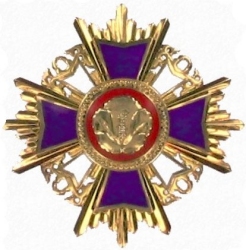
Presidential Decree #2929, enacted on Feb. 27, 1967, revised Korea’s system of Orders and Medals. It included the creation of a “New” Civil Merit Order. The previous Order of Cultural Merit was absorbed by this new order. The award criteria states: “These shall be given to those who have rendered distinguished service in the field of politics, economy, social welfare, education, art, science, physical education or other culture, and have thus made distinguished contributions to the advancement of national welfare and to the prosperity of the nation”. The new Order of Civil Merit is an award that provides a means by which the government could award virtually anyone who increased the national prestige. In effect, it is an Order of Citizen Merit or Civilian Merit.
There were three different series that used this particular pendant, 1967, 1969 and 1971. There were ribbon color changes between 1967 and 1971. The only change in the 1969 Series is the lapel pin, which went from round to rectangular.
One word of caution: There are numerous websites where the Order of Civil Merit, Mugunghwa Class is referred to as the Order of Mugunghwa or worse yet, the Grand Order of Mugunghwa. This is absolutely incorrect. The Grand Order of Mugunghwa is an entirely different Order reserved for the President of Korea and foreign heads of state, and their respective spouses.

Photo courtesy of the Korean Presidential Archives 대통령기록관
Public Information Office, Management #CET0028578
1967 SERIES
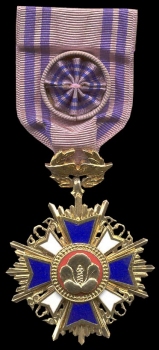
목련장 (木連章)
1967 Series
In the 1967 Series, all classes have a 38 × 10 mm ribbon bar and a 17 mm round lapel pin. The ribbon has a base color of purple/violet 보라색. Any stripes are blue 청색. I have seen websites where the primary ribbon color is described as ‘light’ purple. Variations in color are known to exist, generally due to fading from sun damage. The stripe patterns and dimensions on the ribbon bars closely mimic the ribbon. There are no weights given in the legislation. The Mugunghwa flower found in the center of the badges and breast stars is also found on the lapel pins, but not on the ribbon bars. A Mugunghwa Medal specifically sized for women was created.
The Classes are:
- Mugunghwa (Hibiscus) Medal 무궁화장 (無窮花章). Hibiscus, better known as the Rose of Sharon. The pendant has a major diameter of 60 mm. It is mounted on a 1700 × 80 mm sash that is a solid purple 보라색 in color. The breast star has a diameter of 70 mm.
- Mugunghwa Medal 무 궁 화 장 (無窮花章), (sized) for Ladies. The pendant has a major diameter of 45 mm. It is mounted on a 1700 × 70 mm sash that is a solid purple in color. The breast star has a major diameter of 50 mm.
- Moran (Peony) Medal 모란장 (牡丹章). The pendant has a major diameter of 55 mm and is mounted on a 600 × 38 mm cravat. The ribbon has two 1 mm purple edge stripes and two 7 mm blue 청색 stripes, one on each side of the 22 mm purple center stripe. The breast star has a major diameter of 60 mm.
- Dongbaeg (Camellia) Medal 동백장 (冬栢章). The pendant has a major dimension of 50 mm and is mounted on a 600 × 38 mm cravat. The ribbon has two 4 mm purple edge stripes and two 5 mm blue stripes, with one on each side of the 20 mm purple center stripe. There is no breast star.
- Mogryeon (Magnolia) Medal 목련장 (木連章). The pendant has a major dimension of 45 mm and is mounted on a 110 × 38 mm breast ribbon. The ribbon has four 2 mm blue stripes, with two on each side of a 20 mm purple center stripe. There is a rosette in the center of the drape.
- Seogryu (Pomegranate) Medal 석류장 (石榴章). The pendant has a major dimension of 40 mm and is mounted on a 110 × 38 mm breast ribbon. The ribbon has two 5 mm purple edge stripes and two 2 mm blue stripes, with one on each side of a 24 mm purple center stripe. There is no rosette on the drape.
1969 SERIES
A new Decorations Law Enforcement Decree, Presidential Decree #4466 was issued on Dec. 19, 1969. The 1969 series is identical to the 1967 series in all respects except one. The earlier 1967 series had a 17 mm round lapel pin, but the 1969 series has a 12 × 8 mm rectangular lapel pin. There is a Mugunghwa flower in the center of both styles of lapel pin. The stripes and colors on the 1969 lapel pin closely resemble those on the ribbons and ribbon bars. There are no dimensions given for the stripes.
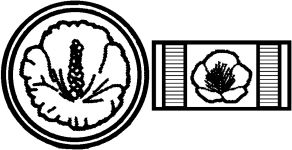
1970 SERIES (2)
On June 13, 1970, a new Decoration Law Enforcement Decree 상훈법시행령, Presidential Decree #5035 was enacted. The most significant difference between this legislation and the earlier one is found in the Merit Medals, not the Orders. For the Order of Civil Merit, this legislation is identical to the previous 1969 legislation.
On Nov. 17, 1970, a new Decoration Law Enforcement Decree 상훈법시행령, Presidential Decree #5388 was enacted. For the Order of Civil Merit, this legislation is also identical to the previous 1969 legislation.
1971 SERIES
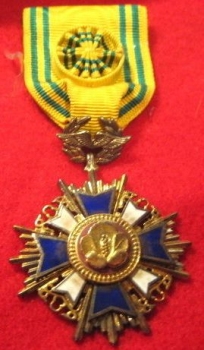
목련장 (木連章)
1971 Series
There were three different series that used this particular pendant, 1967, 1969 and 1971. There were ribbon color changes between 1967 and 1971. The only change in the 1969 Series is the lapel pin, which went from round to rectangular.
On June 30, 1971, the Korean government issued a new Decorations Law Enforcement Decree, Presidential Decree #5688. Except for the Mugunghwa Class medals, the 38 × 10 mm ribbon bars have the same stripe colors and widths as the ribbons. The colors of the 8 × 12 mm lapel pin mimic the cravat and ribbon bar, but the legislation does not have specific width information. The center design found on the pendants and breast stars is also found on the lapel pin, but not on the ribbon bar.
- Mugunghwa (Hibiscus) Medal 무궁화장 (無窮花章). Hibiscus, better known as the Rose of Sharon. The pendant has a major diameter of 60 mm. It is mounted on a 1700 × 80 mm sash that is a solid yellow 황색 in color. The breast star has a diameter of 70 mm. The 38 × 10 mm ribbon bar has two 1 mm yellow edge stripes and two 6 mm green 록색 stripes, with one on each side of a 24 mm yellow center stripe. The stripe colors and widths on the 8 × 12 mm lapel pin mimic the ribbon bar, but the legislation does not have specific width information.
- Mugunghwa Medal 무 궁 화 장 (無窮花章), (sized) for Ladies. The pendant has a major diameter of 45 mm. It is mounted on a 1700 × 65 mm sash that is a solid yellow in color. The breast star has a major diameter of 50 mm. The ribbon bar and lapel pin are identical to the men’s size.
- Moran (Peony) Medal 모란장 (牡丹章). The pendant has a major diameter of 55 mm and is mounted on a 600 × 38 mm cravat. The ribbon has eight 2 mm green stripes, with four on each side of the 12 mm yellow center stripe. The breast star has a major diameter of 60 mm.
- Dongbaeg (Camellia) Medal 동백장 (冬栢章). The pendant has a major dimension of 50 mm and is mounted on a 600 × 38 mm cravat. The ribbon has six 1.5 mm green stripes, with three on each side of the 19 mm yellow center stripe. There is no breast star.
- Mogryeon (Magnolia) Medal 목련장 (木連章). The pendant has a major dimension of 45 mm and is mounted on a 50 × 38 mm breast ribbon. The ribbon has four 2 mm green stripes, with two on each side of a 22 mm yellow center stripe. There is a rosette in the center of the drape.
- Seogryu (Pomegranate) Medal 석류장 (石榴章). The pendant has a major dimension of 40 mm and is mounted on a 50 × 38 mm breast ribbon. The ribbon has two 2 mm yellow edge stripes and two 2 mm green stripes, with one on each side of a 29 mm yellow center stripe. There is no rosette on the drape.
1973 SERIES
In 1973, the Republic of Korea created the Order of Saemaeul Service Merit and the Order of Sports Merit. It also resurrected the Order of Cultural Merit. The award criteria for two of these new Orders, the Sport Merit and Cultural Merit, were previously covered by the Civil Merit Order and were consequently dropped from the Civil Merit award criteria.
On Nov. 1, 1973, the Korean government issued a new Decorations Law Enforcement Decree, Presidential Decree #6916. The design of the pendants for the Order of Civil Merit was changed. The Classes retained the names used in the previous series. The primary color on the ribbons, ribbon bars and lapel pins is described as dark yellow 짙은노랑색 with the stripes being green 녹색. Each class has a 38 × 10 mm ribbon bar and a 12 × 8 mm lapel pin. Except for the Mugunghwa Class, the pattern, and dimensions of the stripes on the ribbon bar match those found on the ribbon. The lapel pin mimics the ribbon bar, but within the legislation, there are no dimensions given for the width of the stripes. There is a Mugunghwa flower in the center of the lapel pin, but not on the ribbon bars.
The symbols employed are: The wings of the dove that is found on the suspension device symbolize peace, while the laurel wreath, which is also found on the suspension device, symbolizes peace and freedom. The sun’s rays symbolize the heightened dignity of the country. The scarlet red color symbolizes loyalty. The dotted circle means unity and solidarity. The Mugunghwa (flower) symbolizes the Republic of Korea. The yellow color on the ribbon means hope and solidarity, while the green means creativity.
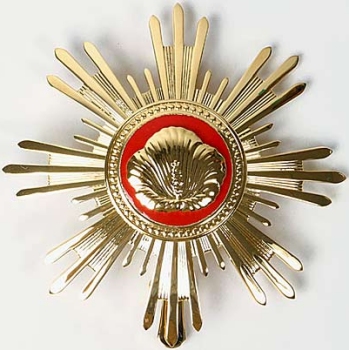
The classes are:
- Mugunghwa (Hibiscus) Medal 무궁화장 (無窮花章). The pendant has a major diameter of 60 mm and weighs 36g. It is mounted on a 1700 × 80 mm sash that is described as dark yellow 짙은노랑색 color. There are no stripes on the sash. The breast star has a major diameter of 70 mm and weighs 46.7g. Within the legislation there are no dimension for the stripes on the ribbon bar, but later legislation has two 6 mm green stripes, one on each side of a 24 mm yellow center.
- Mugunghwa Medal 무 궁 화 장 (無窮花章), Women’s size. The pendant has a major diameter of 50 mm and weighs 26.7g. It is mounted on a 1700 × 65 mm sash. The breast star has a major diameter of 55 mm and weighs 32g. The ribbon bar and lapel pin are identical to those used for the men’s size.
- Moran (Peony) Medal 모란장 (牡丹章). The pendant has a major diameter of 55 mm and weighs 32g. It is mounted on a 600 × 38 mm cravat. The cravat has eight 1.5 mm green stripes, four on each side of a 13 mm yellow center stripe. The breast star has a major diameter of 60 mm and weighs 34.7g.
- Dongbaeg (Camellia) Medal 동백장 (冬栢章). The pendant has a major dimension of 50 mm and weighs 26.7g. It is mounted on a 600 × 38 mm cravat. The ribbon has six 1.5 mm green stripes, three on each side of a 17 mm yellow center. There is no breast star.
- Mogryeon (Magnolia) Medal 목련장 (木連章). The pendant has a major dimension of 50 mm and weighs 26.7g. It is mounted on a 100 × 38 mm breast ribbon. The ribbon has four 1.5 mm green stripes, two on each side of a 24 mm yellow center. There is a rosette on the drape.
- Seogryu (Pomegranate) Medal 석류장 (石榴章). The pendant has a major dimension of 50 mm and weighs 25.7g. It is mounted on a 100 × 38 mm breast ribbon. The ribbon has two 2 mm yellow edge stripes with two 2 mm green stripes, with one on each side of a 30 mm center stripe. There is a rosette on the drape.
1984 SERIES
On Jan. 23, 1984, the Civil Merit Order was modified by Presidential Decree #11336.
On Jan. 23, 1984, the sizes and/or weights were changed on all the pendants and breast stars. The Classes retained the same names used in the previous series. Each class has a 38 × 10 mm ribbon bar and a 12 × 8 mm lapel pin. Except for the Mugunghwa Class, the pattern, and dimensions of the stripes on the ribbon bar match those found on the ribbon. The lapel pins mimic the ribbon bars, except for the inclusion of a Mugunghwa flower in the center. One note of caution, there are five badges/pendants which have the same physical dimensions but differ in weight. These are the 3rd, 4th, 5th Class pendants, and the 1st Class pendant in the women’s size, as well as the corresponding pendant on the Civil Merit Medal. Since the physical dimensions are identical, the difference in the weight, indicates that the weight of the ribbon is included.
The classes are:
- Mugunghwa (Hibiscus) Medal 무궁화장 (無窮花章). The pendant has a major diameter of 70 mm and weighs 66g. It is mounted on an 1800 × 80 mm sash that is a solid yellow 황동색 color. The breast star has a major diameter of 80 mm and weighs 79g. The ribbon bar has two 1 mm yellow edge stripes and two 6 mm green stripes, with one on each side of a 24 mm yellow center stripe. The lapel pin is similar to the ribbon bar. There are two 1.5 mm yellow edge stripes and two 1.5 mm green stripes, with one on each side of a 4 mm yellow center stripe. There is a Mugunghwa Flower in the center of the lapel pin, but not on the ribbon bar.
- Mugunghwa Medal 무 궁 화 장 (無窮花章), Women’s size. The pendant has a major diameter of 50 mm and weighs 36g. It is mounted on a 1700 × 65 mm sash. The breast star has a major diameter of 55 mm and weighs 40.5g. The ribbon bar and lapel pin are identical to those used for the men’s size.
- Moran (Peony) Medal 모란장 (牡丹章). The pendant has a major diameter of 60 mm and weighs 47g. It is mounted on a 600 × 38 mm cravat. The ribbon has eight 1.5 mm green stripes, four on each side of a 13 mm yellow center. The breast star has a major diameter of 70 mm and weighs 62g. The ribbon bar has the same stripe widths as the cravat. The lapel pin has eight .2 mm green stripes, four on each side of a 4 mm yellow center stripe.
- Dongbaeg (Camellia) Medal 동백장 (冬栢章). The pendant has a major dimension of 50 mm and weighs 33.5g. It is mounted on a 600 × 38 mm cravat. The ribbon has six 1.5 mm green stripes, three on each side of a 19 mm yellow center. There is no breast star. The ribbon bar has the same stripe widths as the cravat. The lapel pin has six .2 mm stripes, three on each side of a 5 mm center.
- Mogryeon (Magnolia) Medal 목련장 (木連章). The pendant has a major dimension of 50 mm and weighs 32g. It is mounted on a 100 × 38 mm breast ribbon. The ribbon has four 1.5 mm green stripes, two on each side of a 24 mm yellow center. There is a rosette on the drape. The lapel pin has four .3 mm stripes, two on each side of a 5 mm yellow center stripe.
- Seogryu (Pomegranate) Medal 석류장 (石榴章). The pendant has a major dimension of 50 mm and weighs 32g. It is mounted on a 100 × 38 mm breast ribbon. The ribbon has two 2 mm yellow edge stripes, and two 2 mm green stripes, with one on each side of a 30 mm yellow center stripe. There is a rosette on the drape. The lapel pin has two 2 mm yellow edge stripes and two .5 mm green stripes, with one on each side of a 5 mm yellow center stripe.
CURRENTLY
Since 1984, the Decorations Law Enforcement Decree has been changed 19 times. The current legislation is Presidential Decree #30517 and was enacted on March 10, 2020. In the intervening years, the only major change was to the Order of Civil Merit, Mugunghwa Medal (sized) for Ladies. It was found to be discriminatory and was dropped in 2016.1 There has been one minor wording change concerning one of the ribbon colors. The Korean legislation originally used the term 황동색 for yellow. They now use the term 노란색, which still translates as yellow. The word “황동” translates as brass, implying that 황동색 is a brass color or brass yellow. All the other sizes, patterns, etc., of the 1984 legislation, are still in effect, except for the lapel pins.
- Mugunghwa (Hibiscus) Medal 무궁화장 (無窮花章). The 16 × 10 mm lapel pin has two 2 mm yellow edge stripes and two 2 mm green stripes, with one on each side of a 5 mm yellow center stripe. It is not clear why the total of the stripe widths do not match the width of the lapel pin.
- Discontinued in 2016.
- Moran (Peony) Medal 모란장 (牡丹章). The 16 × 10 mm lapel pin has eight .3 mm green stripes, four on each side of a 5 mm yellow center stripe.
- Dongbaeg (Camellia) Medal 동백장 (冬栢章). The 16 × 10 mm lapel pin has six 1.5 mm stripes, three on each side of a 6 mm center.
- Mogryeon (Magnolia) Medal 목련장 (木連章). The 16 × 10 mm lapel pin has four .4 mm green stripes, two on each side of a 6 mm yellow center stripe.
- Seogryu (Pomegranate) Medal 석류장 (石榴章). The 16 × 10 mm lapel pin has two 2.7 mm yellow edge stripes and two .8 mm green stripes, with one on each side of a 6 mm yellow center stripe.
The current Classes for the Order of Civil Merit are:
